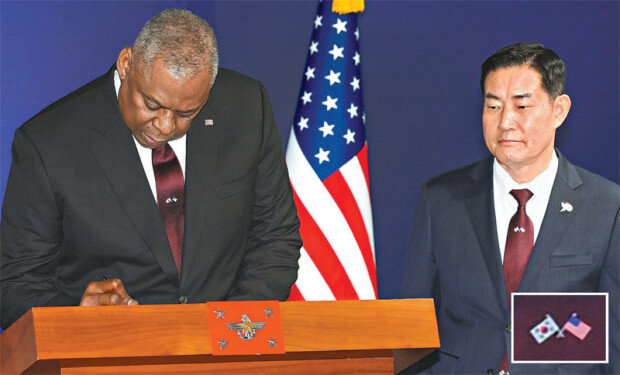ROK, US to leverage top three U.S. nuclear forces to counter N. Korea’s nuclear weapons
ROK, US to leverage top three U.S. nuclear forces to counter N. Korea’s nuclear weapons
Posted November. 14, 2023 08:28,
Updated November. 14, 2023 08:28

The Tailored Deterrence Strategy (TDS), established collaboratively by South Korea and the United States to address North Korea's nuclear weapons and other weapons of mass destruction (WMD), has undergone its first revision in a decade. According to reports, the updated North Korean nuclear deterrence strategy incorporates detailed plans for leveraging the extended deterrence (nuclear umbrella) provided by the U.S. military's three principal nuclear forces, comprising intercontinental ballistic missiles (ICBMs), strategic bombers, and nuclear-powered strategic submarines. “It includes new measures, such as guidelines for the joint planning and implementation of the deployment of extended deterrence forces by South Korea and the United States,” a senior official from the Ministry of National Defense stated.
Minister of National Defense Shin Won-sik and U.S. Secretary of Defense Lloyd Austin convened the ROK-US Security Consultative Meeting (SCM) at the Ministry of National Defense in Seoul on Monday, during which they signed the TDS amendment. In a joint SCM statement, South Korea and the United States announced, “The revised '2023 TDS' incorporates guidelines for leveraging all categories of U.S. military capabilities, encompassing U.S. nuclear capabilities, in conjunction with South Korea’s conventional capabilities, to prepare for potential nuclear and WMD attacks by North Korea.”
The Tailored Deterrence Strategy (TDS), initiated in 2013, stands as the singular bilateral strategic document crafted by the United States in collaboration with its allies. Designated as a level 2 military secret, its contents have not been disclosed to the public. While the initial TDS encompassed comprehensive military response measures by South Korea and the United States, addressing situational scenarios like North Korea's nuclear threat, imminent use of nuclear weapons, and actual use of nuclear weapons, the revised TDS is reported to incorporate even more detailed response measures tailored to specific situational scenarios.
Apart from the joint statement, South Korea and the United States have additionally adopted and unveiled the “ROK-US Alliance Defense Vision” for the first time in four years since 2019. The document explicitly declares, "North Korea is our most fundamental and urgent threat."
Hyo-Ju Son hjson@donga.com






![[단독]“권성동, ‘王’자 노리개 등 장식 상자 2개로 1억 받았다”](https://dimg.donga.com/c/138/175/90/1/wps/NEWS/IMAGE/2026/01/22/133211754.1.jpg)
